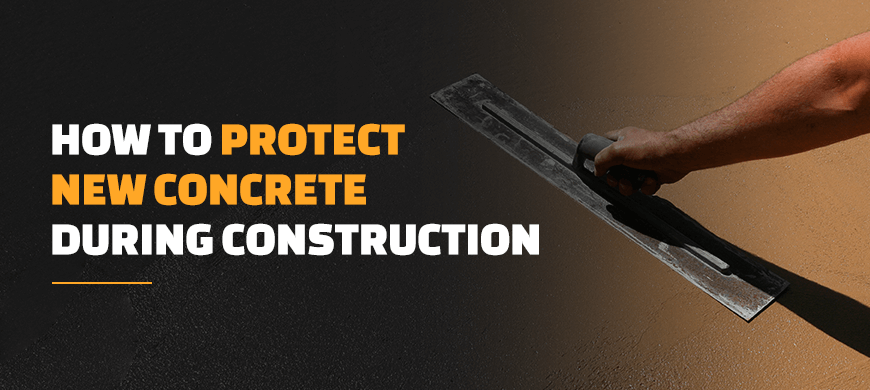
How to Protect New Concrete During Construction
Posted By:Dynamic Concrete Pumping , Date: Oct 6, 2020

Concrete is found in homes, businesses and commercial properties all over the world, thanks to its durability, resilience and versatility. However, for all its applications and benefits, concrete is by no means indestructible and can be easily damaged, especially during the construction process.
In this guide, we’ll go over the most common ways that concrete is damaged and offer tips for protecting your concrete slab during commercial construction.
How to Prevent Concrete Stains
One common misconception about concrete is that it cannot be stained, but it is actually a very porous material due to the many aeration holes in the slab. These holes result from the random way that concrete is mixed and poured. Because this surface is porous, it will quickly absorb any spills that land on it. This process is so quick that sometimes there isn’t even enough time to mop it up. By the time you’ve grabbed a cloth, the liquid’s likely already been drawn into the concrete.
When protecting your concrete during construction, keep in mind that it can be marked or discolored in the following ways:
- Blue or red chalk: Avoid using blue or red chalk on your concrete floor, as they cannot be removed and can be easily seen through most stain colors. Instead, when marking your concrete, use orange chalk because you can wash it away completely with water.
- Taping the floor: Although it may seem harmless, you should avoid taping your concrete floor at all costs. When the tape is pulled off, it will take tiny particles with it from the surface of the concrete. When this area is stained later on, the stain will appear darker here than other areas of the floor.
- Leaving metal on the floor when it’s wet: Don’t leave nails, screws or any other metal objects on a wet concrete floor. The moisture will cause the nails to rust, which in turn will leave nail-shaped, red spots on the concrete. Similar looking blemishes can result if you leave lumber on the floor.
- High-viscosity oil leaks: High-viscosity oil is excellent for lubricating tiny, intricate parts of machinery, but when it encounters porous concrete, it will seep into the pores within minutes. Oil-based products typically encounter concrete on a construction site in two ways. One is the machines used to thread pipes, which uses oil for lubricating the cutting tools and tends to fling oil droplets all over the place. Avoid this by requesting that no pipe threading be performed anywhere near your concrete. Oil is also commonly introduced from scissor or hydraulic lifts, which leave trails of oil spots all over as the operator drives around. To avoid this issue, you can diaper these lifts when on concrete. Just make sure the diapers are emptied or replaced regularly, as they can get so full that they fail and dump large puddles of oil all over your floor.
In other words, don’t use anything on a concrete floor that you would not put on a hardwood floor. While there are techniques to remove these blemishes, the results will not perfect, so it’s better to refrain from using these materials on concrete altogether.
How to Prevent Chips and Scratches in New Concrete
New concrete can be chipped and scratched in many ways. To protect concrete from construction damage, avoid all of the following actions:
- Nailing: If you’re planning to drive nails into your concrete floor for wall braces, keep in mind that this will leave large, unsightly holes when you remove the nails later on. To avoid this situation you have two options: do not drive nails into your concrete floor or, if you do, do not remove them afterward. When bracing your walls, we recommend that you nail the foot of your brace to the opposite wall’s baseplate.
- Pouring acid: Under no circumstances should you pour acid on your concrete floor. Acid neutralizes the lime in the concrete, which will make it unstable.
- Cutting plywood: If you cut plywood or other materials on 2-by-4s laying on the concrete surface, the blade may strike the concrete when the plywood flexes. This will leave unattractive score marks on the surface and should be avoided.
- Screws in lift tires: The tires on hydraulic lifts are made of soft rubber, and when they roll over a nail or screw, the rubber tire picks it up. Then, as the lift rolls along, the nails or screws stuck in the tire leave chips in your concrete. One was to minimize lifts from running over metal objects is by installing tire bags, which will stop around 80% of screws and nails from getting picked up. This is because the canvas, unlike the rubber, isn’t soft. However, as some screws will still get picked up, you still need to inspect the tires.
- Drops: No matter how careful the workers are, at some point, materials or tools will get dropped and make holes in the concrete. Luckily, however, if this happens, you can use a product designed to dial in the patch, making it difficult to spot. Many products are available in several colors, allowing you to closely match the color of your slab after it’s polished. They also take color and hold polish well.
- Entrance damages: One area of the construction site where damage is particularly frequent is at the entrances. When workers and equipment come in from outside, they often bring debris in also, which abrades the concrete by the entrance. Mud can get ground into the concrete, staining it. In colder climates, salt from sidewalks and roads also gets brought in. To protect the concrete near the entrances, we recommend that you lay down mats specifically designed for this purpose. These mats often feature self-stick surfaces, so you can just peel off the backing paper and then apply it to the surface.
If you want to protect polished concrete floors during construction, we recommend that you lay down mats on your entire floor.
Dynamic Concrete Pumping, Inc. for All Your Concrete Pumping and Placing Needs
At Dynamic Concrete Pumping, we’ve been providing high-quality concrete services for more than 40 years. Our business is based in Calgary, Alberta, and built around a professional, knowledgeable staff. We strive to update our equipment continually as technology in the industry improves.
Our fleet of reliable, cutting edge pumping equipment includes 10-foot-wide trowels, line pumps, boom pumps and separate placing booms. Our hydraulic equipment all uses clarity fluid, an environmentally friendly alternative to normal hydraulic fluid.
If you’re interested in temporary concrete floor protection or would like to discuss a concrete floor protection plan, feel free to get in touch with our friendly staff by filling out our contact form or calling us at 1-877-236-9511.

